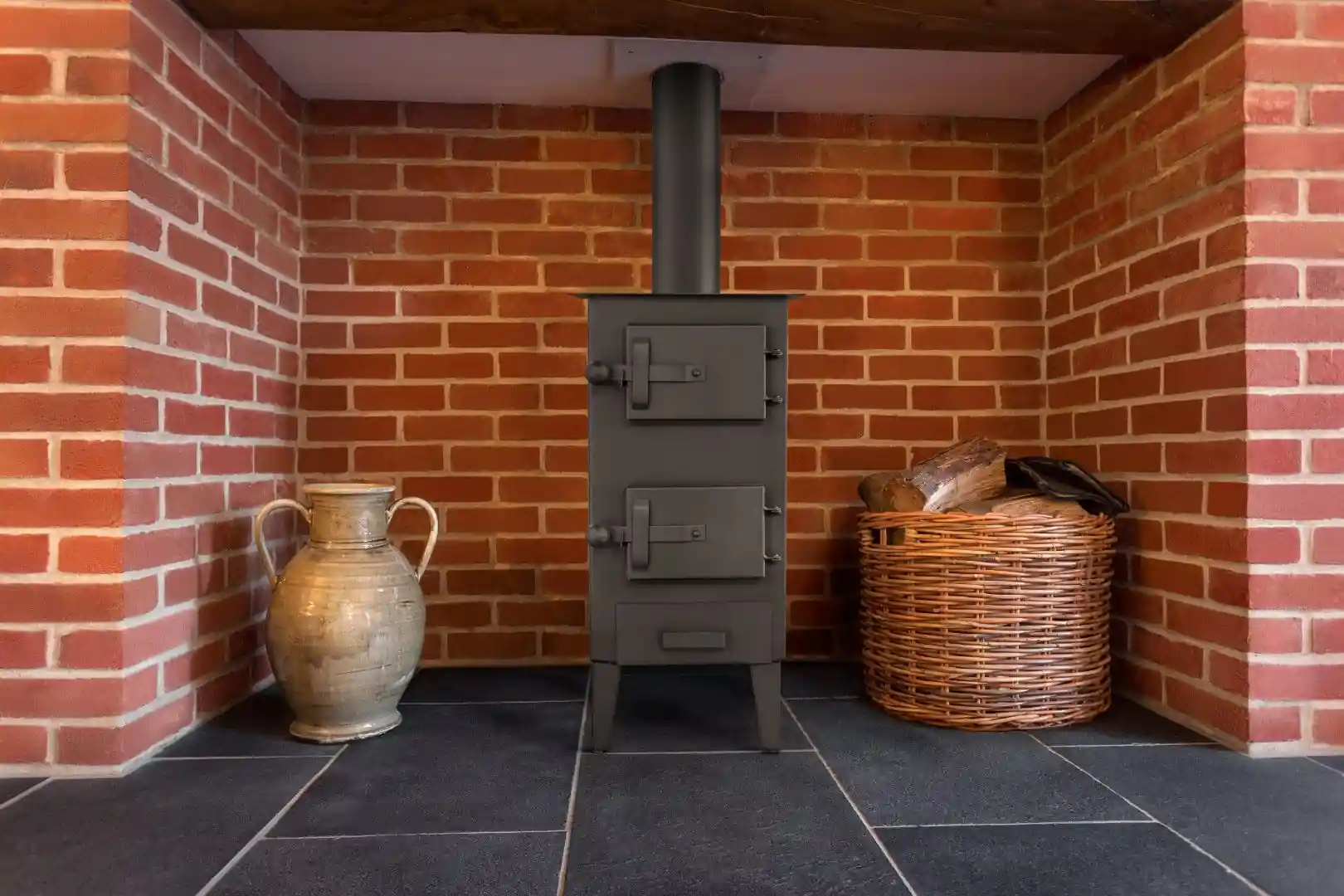What if your garage wasn’t just a freezing slab of concrete in winter — with cold air sneaking in through the garage door and icy chills radiating off the garage floor — but a warm, usable space no matter how cold it gets? In 2025, more people are turning their garages into something more — workshops, gyms, hobby zones, even cozy hideouts. And the secret weapon? A solid, reliable wood stove for a garage.
Forget cranking up inefficient electric heaters that barely dent the chill. Today’s best garage wood stoves deliver serious warmth, off-grid peace of mind, and energy savings that actually matter — especially with heating costs climbing. Whether you’re eyeing a compact cast iron stove, a powerhouse wood burner with a blower, or weighing a pellet stove vs wood stove decision, this guide is for you.
In the next few scrolls, you’ll find:
- The top-rated garage wood stoves of 2025
- Budget-friendly picks for small and large garages
- Real-world installation tips (with safety in mind)
- Pro tricks to keep the fire burning right, season after season
So if you’re tired of shivering through your projects or want a space that finally works year-round — read on. Your perfect heating solution is probably just a firebox away.
Best Wood Stoves for Garages in 2025: Buyer’s Guide & Expert Picks
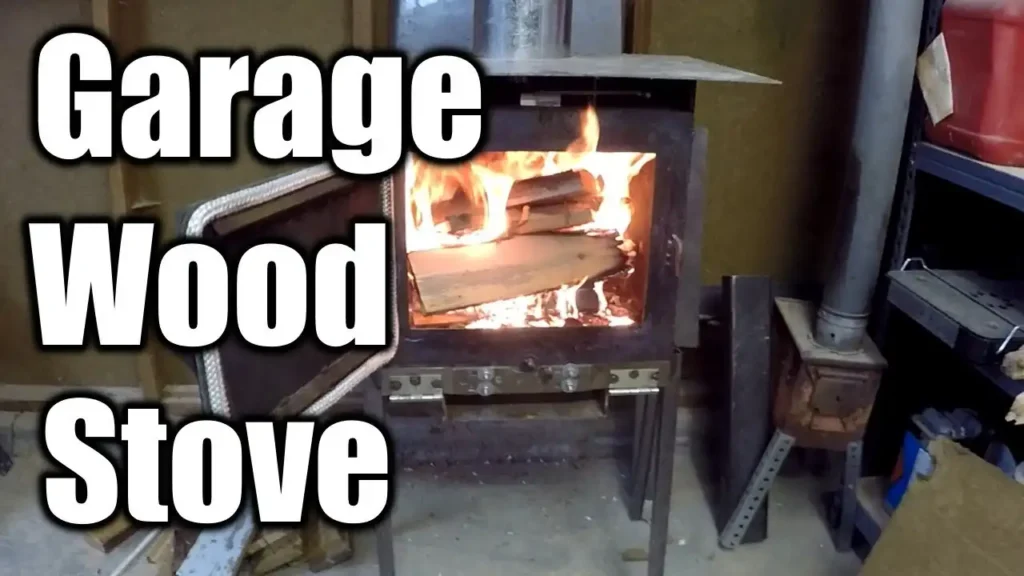
Let’s be real — choosing the best wood stove for garage use isn’t as simple as picking the one that “looks right.” There’s more to it: heat output, build quality, safety features, and even how it fits into your layout — especially if your garage doubles as a workshop, man cave, or just a quiet place to escape the noise.
This guide breaks down our top picks for 2025 based on real user reviews, expert input, and personal experience (yep — some of these have been tested in freezing Northwest garages with zero insulation).
From rugged cast iron stoves to sleek EPA-approved wood burners, we’ve listed something for every type of garage, whether it’s small, detached, or fully finished with a dust collection system humming in the corner.
Some of these models are energy savers. Others? Just reliable heat machines. Either way, if you’re serious about staying warm without draining your wallet on electric heat or garage heater upgrades, this is where you’ll want to start.
Pro Tip: When comparing stoves, always look at Firebox Width (in.), BTUs, and whether it supports secondary burn — those three things alone can tell you a lot about performance.
Top Benefits of Using a Wood Stove in Your Garage
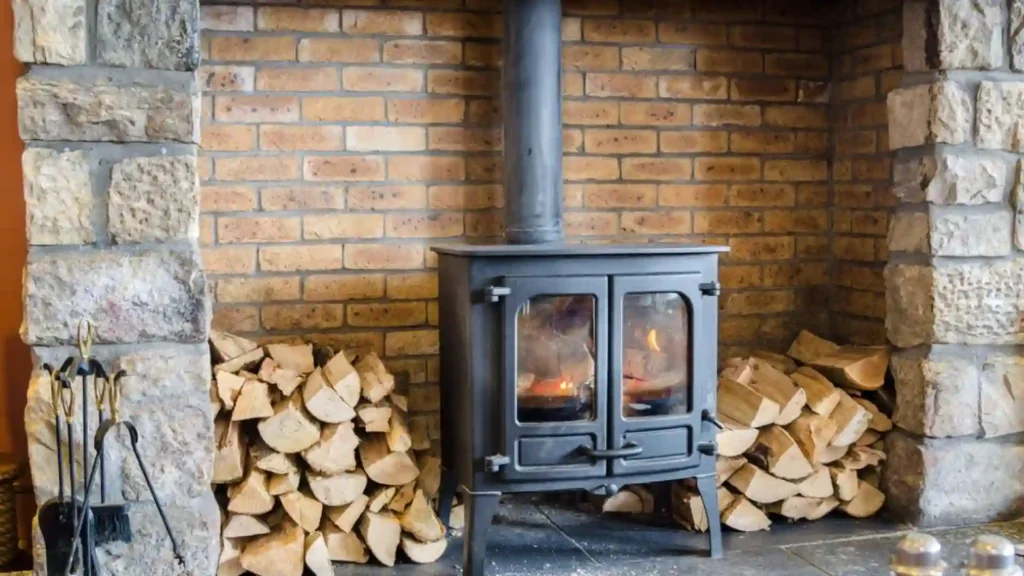
Okay, let’s slow down for a sec. Before diving into product picks and BTUs and clearances, let’s talk why. Why would anyone go with a wood stove for a garage when there’s a pile of plug-and-play heaters everywhere — or when upgrading to a smart garage door opener seems like the only modern touch most people think about? Well, here’s why.
Well… here’s why.
Efficient Heat for Large & Small Spaces
The thing about wood stoves? They don’t mess around. When you size it right, the heat distribution is — honestly — kind of perfect. Unlike electric heaters that give you that direct blast and then leave cold pockets, a wood burning stove naturally fills the whole space with warmth. No fancy ducts. Just good heat.
Here’s a quick idea of what heating coverage can look like:
| Stove Type | BTUs | Ideal Garage Size |
|---|---|---|
| Small Cast Iron Stove | 30,000–50,000 | Up to 750 sq ft |
| Mid-Sized EPA Approved Unit | 50,000–80,000 | 750–1,500 sq ft |
| Large Firebox Stove | 100,000+ | 1,500–2,700+ sq ft |
A garage wood stove with blower can push that warm air even further, especially if your space has high ceilings or isn’t well-insulated. It’s not just about heat — it’s how well it circulates.
And BTUs? Think of them like horsepower, but for warmth. You don’t want to under-power. But you also don’t want to turn your garage into a sauna. Well… unless that’s your thing.
Cost-Effective Heating Over Time
Let’s talk money. Because yeah — up front, a wood stove can feel like a bigger investment compared to a cheap electric heater. But that’s just half the story.
If you’re heating a garage all winter — especially in colder spots like Northwest Oregon — those electric bills? They pile up. But with wood (especially if you’ve got your own supply or buy in bulk), your cost per BTU drops way down. Over a season? The savings can honestly surprise you.
Let me put it another way:
- A mid-range pellet stove for garage burns $4–6 of pellets per day (avg 12 hrs use)
- An electric heater might cost $5–8 per day in electricity
- A well-insulated garage and a full firebox of cast iron stove heat? Maybe $2/day or less if you DIY wood
Pro Tip: Want long-term ROI? Combine a wood stove with basic energy-saving gear — think insulated roll-up doors, fireproof inserts, and even a thermal fan. It’s not sexy… but it works.
Key Features to Consider Before Buying a Garage Wood Stove
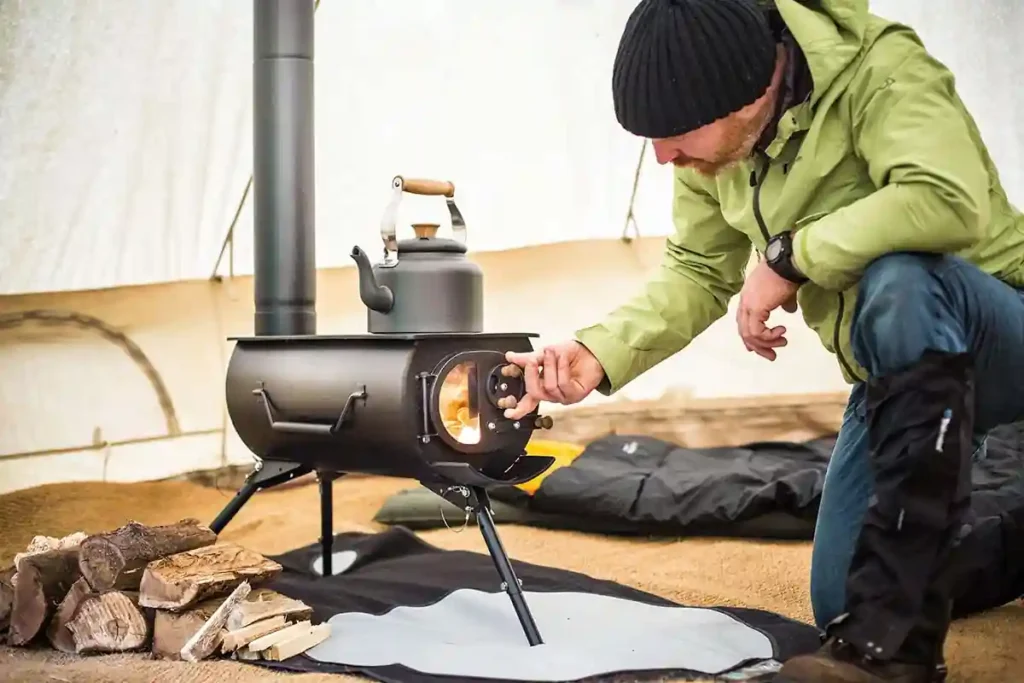
So, you’ve decided a wood stove for a garage is the right move. Cool. But now comes the tricky part: Which one? Honestly, the best wood stove for garage setups can look very different depending on what you’re actually doing out there. Painting? Storing tools? Running a dust collection system? All of that matters.
Here’s what to keep in mind before you light anything on fire — literally or financially.
Size & Clearance Requirements
Not all garages are built the same. Some are cramped, some have vaulted ceilings, and some are… well, storage graveyards with barely any floor space. Before anything else, measure your garage’s square footage. Not just rough estimates — use a tape.
Also? Think about clearance. A wood stove in detached garage or a tight single-car garage needs space around it for safety. And some stoves, especially older solid fuel burners or vintage potbelly stoves, need more distance than you’d guess.
Here’s a basic guide:
| Stove Type | Minimum Clearance (Sides) | Back Clearance |
|---|---|---|
| Cast Iron (Standard) | 18 inches | 12–18 inches |
| EPA Approved (Modern) | 12 inches | 6–12 inches |
| Micro Stove / Mini Unit | 6–10 inches | 4–6 inches |
And hey — if you’re tight on space, don’t forget about wall-mounted heat shields and fireproof bases. It’s not just smart. It’s also something your insurance company will care a lot about. (Don’t ask how I know.)
Heating Capacity & Insulation Factors
Here’s where it gets weirdly math-y. You can’t just pick a wood stove based on vibes. You need something that matches the size of your space and its insulation levels. That cute wood stove in garage code compliant setup won’t do much if your garage has gaps, no ceiling insulation, and an old drafty door.
So, think in BTUs and CUFT of air space, not just square footage.
- A basic rule: 20–25 BTUs per square foot (more in cold climates)
- Example: A 500 sq ft garage = 10,000 to 12,500 BTUs minimum
Oh — and insulation? Total game-changer. With proper R-value insulation and maybe an eco-electric heater backup, you can go smaller on stove size without freezing.
Also worth a mention: Fire wool and fireplace safety paint go a long way in making sure your walls, ceiling, and floor hold up over time.
Material Quality & Build (Cast Iron vs. Steel)
Some people love the classic, cast iron stove look. Others want something sleek and steel. There’s no right answer — but there is a performance difference.
- Cast Iron: Holds heat longer, looks traditional, often heavier. Great for steady warmth.
- Steel: Heats up fast, cools faster. Lighter and often cheaper.
If you’re running short winter sessions — say, a couple hours of woodworking — steel might be ideal. But for all-day warmth in a garage workshop or hybrid gym/office setup? Cast iron wins. Every time.
A few well-known options include:
- Buck Stove (seriously underrated)
- Fisher Momma Bear Stove (classic, vintage style)
- Ben Franklin Stove (looks cool, heats slower)
Safety Features
This one’s big. Bigger than most people realize — especially if you’re installing in a garage with a water heater, dust collection system, or anything flammable.
Look for these in every unit:
- Air-washed glass (helps keep the door clean and the fire visible)
- Secondary burn system (burns internal gasses = cleaner and hotter)
- Thermal switch or thermal fan compatibility
- CO & smoke detector ports or recommendations
- Easy damper wood control
And one more thing — carbon monoxide is real. Install detectors even if your space is small. A wood burner setup is cozy, sure — but not worth risking your lungs for.
Best Wood Stoves for Garages in 2025 – Hot Picks
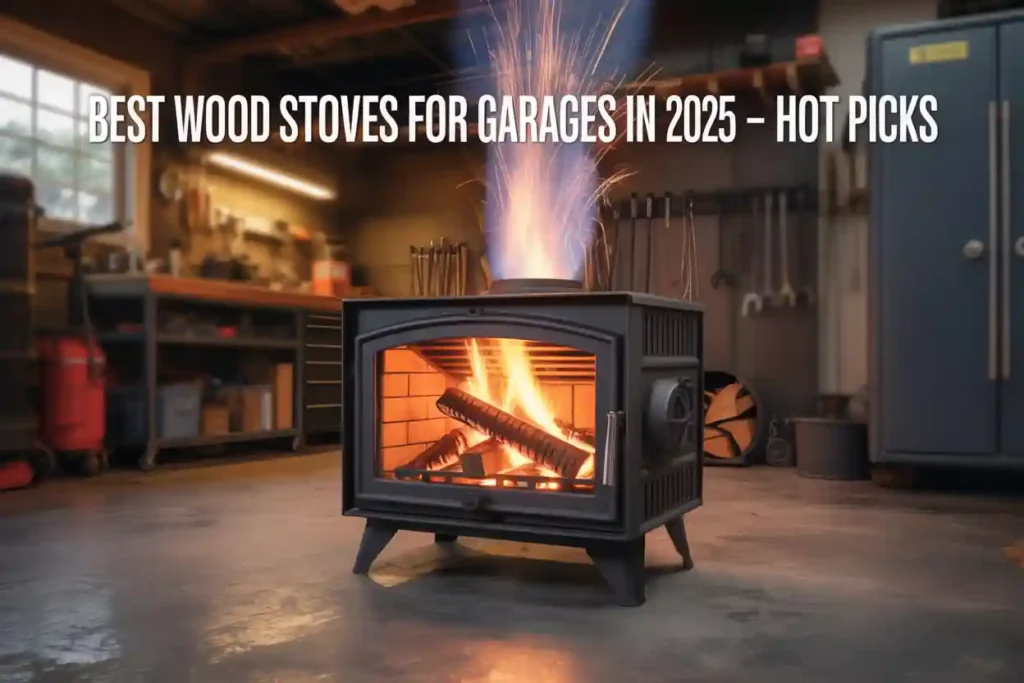
Okay, here we go. The part you probably scrolled down for — no shame in that. Below are the top picks for garage wood stove ideas in 2025. From budget-friendly to big-heat beasts, each one has something unique going for it.
Oh, and yes — most of these have been vetted against Canadian code, US fire safety standards, and modern insurance coverage conditions.
US Stove Company Small Logwood Stove (Top Budget Pick)
Honestly? It doesn’t get more “classic wood stove” than this. Small, sturdy, kind of charming in a vintage way.
- Best for: Garages under 500 sq ft
- Material: Cast iron
- Fuel: Wood only
- EPA Certified: Yes
- Bonus: Doubles as a cast iron skillet warmer (if you’re weird like me and cook in your garage sometimes…)
This thing’s been around forever — and for good reason. Is it fancy? Nope. But it does its job, and does it for under $500 in most local store prices or even Facebook Marketplace if you’re lucky.
Drolet HT3000 (Best for Large Garages)
Need to heat a monster-sized space? Or maybe a garage with a high ceiling, or one that doubles as a full-time workshop? This is the beast.
- Heats up to: 2,700 sq ft
- BTUs: 110,000
- Secondary Burn System: Yes
- Warranty: 5 years
Pro Tip: Install with black double-wall pipe + stainless section through the roof to avoid draft issues.
Worth a Look: Essential Guide to Maynard Street Parking Garage 2025
Honestly, this one might be too much for the average garage. But if you’re in a cold zone — say, North Dakota or deep in the Rockies — it’ll keep you toasty no matter what’s happening outside. (Even if your solar panel electricity setup takes a nap.)
Installation Tips & Safety Guidelines for Garage Wood Stoves
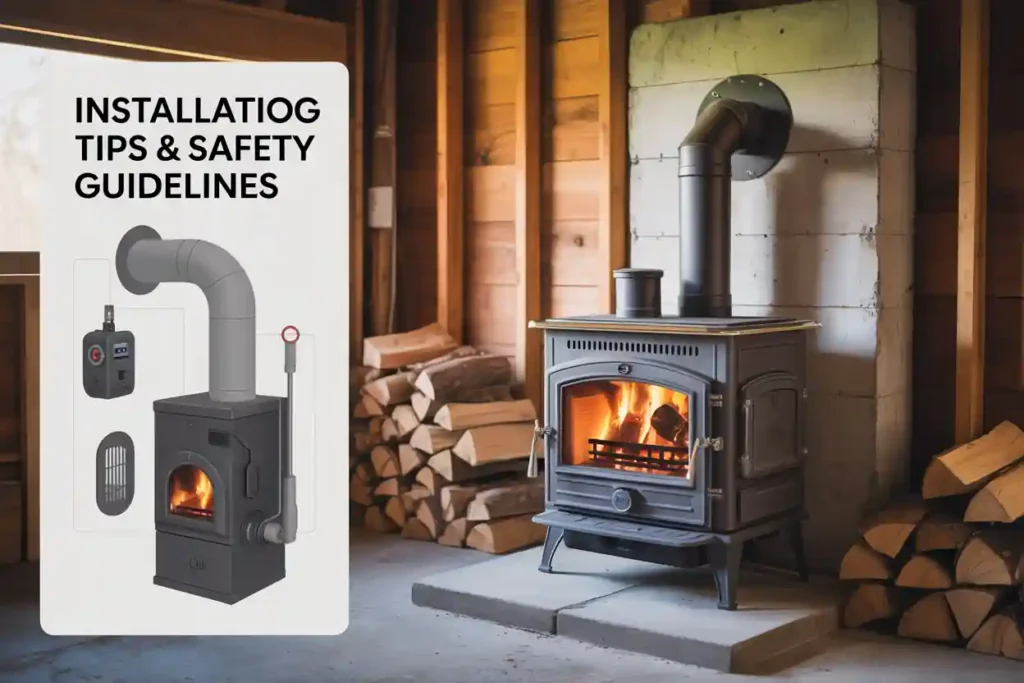
So you’ve picked out your wood stove for a garage — exciting, right? But hold up. Don’t go hauling it into the corner and lighting a fire just yet. Installing a garage wood stove is part strategy, part science, and mostly common sense (plus a little help from your local fire code).
And honestly? One of the biggest risks isn’t the stove itself — it’s how un-seriously some people treat the setup. Let’s not be those people.
Proper Ventilation Setup
You’ve probably heard the phrase flue updraft before — maybe in a video or on a product label. It’s basically how your stove “breathes.” Without proper draft, your cozy fire turns into a smoke machine. Not fun.
Two main options here:
- Vertical chimney system (ideal for most garages — better draft, safer for CO)
- Flue system with horizontal exit (okay for certain detached garages, but trickier to vent right)
Want a pro tip?
Use a thermal fan + double-wall pipe combo. It boosts air movement naturally, especially in bigger garages, and prevents that awkward moment where smoke tries to come back in.
Also — some folks skip using fireproof base pads or don’t extend the pipe high enough. If that’s you, take a second to rethink it. You want that pipe 3 feet higher than the roofline or any surrounding structure. That’s code in most places — and also just smart.
Clearance, Flooring & Wall Protection
Let’s get practical. Here’s what you actually need around your wood stove in detached garage (or even an attached one):
| Protection Area | Minimum Required |
|---|---|
| Floor | Fireproof pad extending 18” beyond stove edge |
| Wall (non-combustible) | 12–18” clearance or shielded to code |
| Ceiling | At least 36” if not shielded or insulated |
Insulated roll-up doors can help retain heat — but make sure they’re well away from the flue line or heat plume. And paint your setup with heat-resistant paint — especially if you’re installing near drywall or wood paneling.
One more thing: spark shields. They’re cheap and kind of ugly… but they work. Especially if you’re using damper wood or older logs that crackle like popcorn.
CO & Smoke Detector Placement
Quick confession — the first time I fired up my old pellet stove for garage use, I didn’t have a carbon monoxide detector. I didn’t think I needed one. That was dumb.
Here’s where to place them:
- One CO detector near the ceiling, within 10 feet of the stove
- One smoke detector overhead, not directly above (false alarms galore)
- Optional: A Nest thermostat or smart monitor, especially if you’re remote-starting stoves or using infrared heaters in combo
Also consider installing a fireproof insert behind your unit and using thermal switch controls if you’re integrating it with other heating solutions like a ground source heat pump or eco-electric heater.
Wood Stove Maintenance: Keep It Burning Bright
Okay. You’ve got the heat. Now you need to keep it. Maintenance isn’t sexy, I know. But if you skip it — well, best-case you’ll waste fuel. Worst-case? Creosote buildup and, yeah… actual fire hazards.
Ash Removal and Cleaning Schedule
Here’s a no-nonsense way to make sure your wood stove for a garage stays reliable all winter (and many winters after).
- Daily: Light scrape and clear firebox
- Weekly: Empty ash pan (let it cool first, always)
- Monthly: Check door seal and fire wool
- Seasonal: Full clean-out before spring
Pro Tip: Use an ash vacuum — not your regular shop vac. Wood ash is super fine and can wreck your filters or worse, start a fire inside the unit if there’s an ember you missed.
Some wood burners like the Englander Blue Ridge 150-I Wood Fireplace Insert come with an air-washed glass system that helps reduce build-up. Others — not so much. You’ll know pretty fast
Chimney and Flue Maintenance
Creosote. It’s basically the villain of every wood stove story. And if you’re burning low-temp fires or cheap wood, you’re making more of it than you think.
How to handle it:
- Sweep the chimney at least twice per season
- Use a chimney brush that matches your flue diameter
- Install a stainless section cap to block moisture and nests
- Burn hotter fires occasionally to “burn off” residue
Some folks also toss in creosote-burning logs. They work — sort of. But they’re no substitute for a physical sweep.
Off-season Storage Tips
When spring rolls around, don’t just walk away from your garage heater and forget about it. Here’s what to do instead:
- Clean the firebox completely
- Apply a rust inhibitor or wipe down with oil
- Block the chimney cap to keep out pests
- Store any unused pellet stoves or components in dry containers
If you’re using a combo setup — like mini splits with a wood backup — this is also a great time to re-balance your energy loads. And maybe check if your homeowners insurance still covers your full heating setup, especially if you added a heating oil tank, outdoor boiler, or… well, anything slightly explosive.Budget Breakdown: How Much Does a Garage Wood Stove Cost in 2025?

Let’s be honest — pricing is all over the place. A basic wood stove for a garage might cost less than a gaming chair, while others rival the price of a used car.
And sure, it’s tempting to just grab the cheapest wood burning stove for garage for sale you find on Facebook Marketplace, but… it’s worth thinking it through a little more — especially when you’re counting on it to warm a concrete garage floor that otherwise stays ice-cold all winter.
Here’s what most garage folks are really paying in 2025 — not the sticker prices, but the total picture.
Stove Price Range by Size/Brand
This is where budget meets reality. From micro stoves to EPA-approved powerhouses, here’s the general price range based on what you’re heating:
| Garage Size | Recommended Stove Type | Price Range (USD) |
|---|---|---|
| <500 sq ft | Small Cast Iron / Portable Wood Stove | $150 – $550 |
| 500–1,000 sq ft | Mid-range Wood or Pellet Stove | $600 – $1,200 |
| 1,000–2,500+ sq ft | Large Wood Stove (Drolet, Buck, HT3000) | $1,200 – $2,500+ |
Long tail keywords integrated naturally here — some of these units double as cast iron stoves, and others (like Fisher Momma Bear Stoves) are collector-level finds but still practical. You’ll also come across Rated 4 Stars & Above models if you’re shopping online, especially through platforms like Home Depot or specialized heating stores.
Installation Costs
This one gets overlooked — a lot. People see the word “DIY” and think, cool, I’ll save cash. But installing a wood stove for a garage setups can have hidden costs:
- DIY Kit (Flue + Pipe + Base + Sealant): $200–$400
- Professional Install (Required in some states): $500–$1,200
- Additional Mods: Like adding a fireproof insert, heat shields, or changing your garage workshop’s layout? Easily another $200–$600
Don’t forget permits. Some areas (especially in Northwest Oregon or Canada) require inspections to meet wood stove in garage code — and skipping it could void your insurance coverage.
Long-Term Savings on Heating Bills
This part’s tricky because savings vary by climate, insulation, fuel source, and whether you’re using backup systems like infrared heaters, eco-electric heater panels, or even a mobile home hot air furnace.
But here’s a very rough idea of what you might save over a 4-month winter:
| Heating Type | Monthly Cost (avg) | 4-Month Total |
|---|---|---|
| Electric Heater | $150 – $250 | $600 – $1,000 |
| Pellet Stove | $100 – $180 | $400 – $720 |
| Wood Stove (self-split wood) | $30 – $80 | $120 – $320 |
Pro Tip: If you heat your garage daily in winter, switching from electric heat to a wood burner setup can pay itself off in 1–2 seasons — especially with rising utility rates and rolling blackouts becoming… well, kind of normal in some areas.
Alternatives to Wood Stoves: Is It the Right Fit for You?
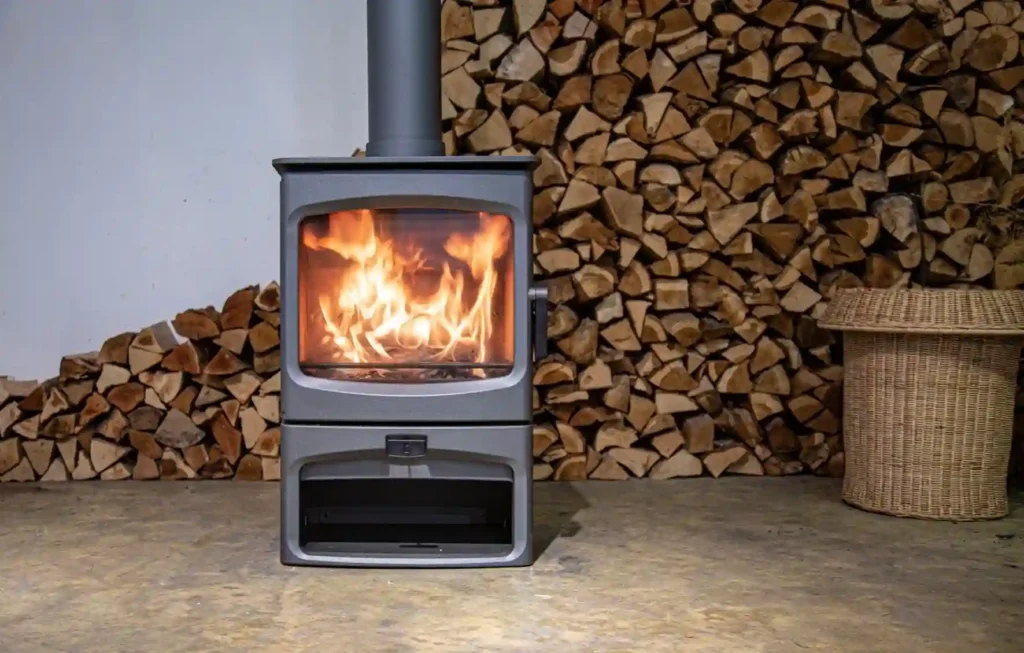
So maybe you’re still unsure. Like, you love the idea of glowing logs and off-grid vibes, but… you’re not totally sold. That’s fair. A wood stove for a garage isn’t for everyone — and in some setups, especially those with poor insulation or an old garage door that leaks cold air, it’s not even the most efficient route.
Let’s walk through a few alternatives that still bring the heat (literally).
Pellet vs. Wood Stoves
They seem similar, right? Both burn stuff. Both warm your space. But the experience — and upkeep — is totally different.
Pellet Stove for Garage:
- Pros: Easier ignition, cleaner burn, consistent heat
- Cons: Needs power to run auger/fan, pellets can be pricey if not bulk-bought
- Great for: People who want fire without chopping wood or managing a live flame constantly
Wood Stove:
- Pros: Works off-grid, no moving parts, uses free/cheap wood
- Cons: More mess, more attention needed
- Great for: DIY-ers, rural setups, backup/emergency heat
Some models, like the King Electric pellet stoves, even blend the best of both — offering programmable features but maintaining that warm, wood-burn feel.
Electric and Infrared Garage Heaters
These are kind of the go-to for renters or folks who just want a no-fuss solution. Plug them in. Turn the knob. Done.
Electric Heater / Infrared Heaters:
- Pros: Instant heat, easy install, great for spot warmth
- Cons: High electric bills, doesn’t circulate air well in large garages
- Not ideal for: Off-grid use or uninsulated garages
If you only use your garage now and then — like, a few hours a week — this might be all you need. But don’t expect it to feel like a wood-heated room. It won’t.
Propane Garage Heaters
These are the torpedo heater types — fast, powerful, loud, and effective. Kind of like jet engines with flames.
Propane Pros:
- Quick heat-up
- No chimney required
- Available in portable options
Propane Cons:
- Loud
- Needs proper ventilation
- Moisture-producing (yes, propane heat = more condensation)
Also worth considering: outdoor boiler systems, mini splits, and for the eco-nerds among us — yes, solar panel electricity heating is getting better every year (though it’s still slow for garages unless you overspend on panels).
Final Thought:
If you’ve made it this far, you probably already know — a wood stove for a garage isn’t just a heating solution. It’s kind of a lifestyle choice. It says: “Yeah, I want warmth… but I also want it my way.”
And in 2025? You’ve got more options than ever. Whether you’re installing a cast iron stove in your garage workshop, testing out a pellet stove for garage coziness, or going full rugged with a wood burner setup that laughs in the face of winter blackouts — you’re choosing control. And heat that feels real.
Let’s not forget — there’s something satisfying about stepping into a once-cold space and having it greet you with a gentle crackle, steady heat, and maybe a little soot under your fingernails. You built that comfort. You maintained it. You earned it.
So, whether you’re going big with a Drolet HT3000, staying small with a US Stove Company unit, or flirting with infrared heaters for those in-between days, the right heat is out there waiting for you.
Just make sure it’s safe. Follow local code. And maybe call your insurance company — just in case.
❓ Frequently Asked Questions:
1. Is a wood stove safe in a garage?
Yeah — if you install it properly. The big risks are poor ventilation, flammable surroundings, or skipping smoke/CO detectors. Use fireproof base pads, check your flue system, and don’t store fuel too close. Easy fixes, really.
2. What’s the best wood stove for a garage in 2025?
Depends on your size and needs, honestly. For small garages, the US Stove Company Small Logwood Stove is solid. For big setups? Try the Drolet HT3000 or something from Fisher Stove if you find one used.
3. Can I use a wood stove in a detached garage?
Totally. In fact, it’s often easier since you’re not dealing with house HVAC integration. Just make sure you’re clear on wood stove in garage code for detached structures — especially if you’re in Canada or colder US states.
4. How often should I clean my garage wood stove chimney?
At least twice per heating season. More if you’re burning green wood or running the stove daily. Use a stainless section cap and chimney brush for best results.
5. Is a pellet stove better than a wood stove for a garage?
Maybe — they’re cleaner and easier to use, especially in tight, well-insulated spaces. But they need power to run. If you’re off-grid or want pure simplicity, wood burners still win.
6. How much does it cost to install a wood stove in a garage?
Rough ballpark? $200 to $1,200 depending on whether you go DIY or hire a pro. Don’t forget extra costs for black double-wall pipe, fireproof inserts, or permits.
7. What size stove do I need for my 2-car garage?
Most 2-car garages are around 400–600 sq ft. A mid-range stove with 40,000–60,000 BTUs is usually plenty — unless you’ve got high ceilings or poor insulation.
8. What’s better for heat — electric heater or wood stove?
Electric is convenient, but expensive long-term. A wood stove with blower spreads more natural heat and can save you serious money over time — especially if you’ve got access to affordable or free wood.
9. Do I need to notify my insurance company if I install a wood stove?
Yes. Always. Some insurance coverage gets voided if you install without documentation, inspections, or using an EPA-approved model. Better to be safe than out-of-pocket.
10. Can I use a stove I bought off Facebook Marketplace?
Sure — just vet it carefully. Check for rust, warped doors, cracked firebox linings, and whether it’s even up to code. Some old stoves look cool but aren’t safe or efficient. Look for Rated 4 Stars & Above if you want to play it safe.

